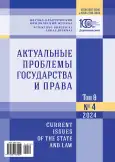Генезис криминологической теории преступной личности: от античности до рубежа XX века
- Авторы: ШЕСТАК В.А.1
-
Учреждения:
- ФГКОУ ВО «Московская академия Следственного комитета Российской Федерации им. А.Я. Сухарева»
- Выпуск: Том 8, № 4 (2024)
- Страницы: 559-566
- Раздел: Актуальные проблемы уголовно-правовых наук
- URL: https://journals.rcsi.science/2587-9340/article/view/303586
- ID: 303586
Цитировать
Полный текст
Аннотация
Исследован генезис формирования теории преступной личности на основе краткого анализа истории научной мысли и криминологических подходов от античных времен до рубежа ХХ века. Изучена проблема преступной личности как сложная, многоступенчатая задача, являющаяся неотъемлемой частью науки криминологии, которой традиционно не уделялось достаточного внимания, поскольку изначально именно вопросы преступности находились в центре научных исследований, но по мере развития науки и изменения современных условий и реалий приоритет начал перемещаться к личностным подходам. Сделан вывод, что и в современных условиях эта проблема не теряет своей актуальности как на теоретическом, так и на практическом уровне, вызванная явной необходимостью ее разработки в целях обеспечения эффективного противодействия преступным проявлениям.
Ключевые слова
Об авторах
Виктор Анатольевич ШЕСТАК
ФГКОУ ВО «Московская академия Следственного комитета Российской Федерации им. А.Я. Сухарева»
Автор, ответственный за переписку.
Email: viktor_shestak@mail.ru
ORCID iD: 0000-0003-0903-8577
ResearcherId: AAA-1725-2019
доктор юридических наук, доцент, профессор кафедры криминалистики
Россия, Российская Федерация, 125080, г. Москва, ул. Врубеля, 12Список литературы
- Кургузкина Е.Б. Криминологическая характеристика личности преступника: социальный аспект // «Охрана и безопасность – 2001»: сб. материалов Всерос. науч.-практ. конф. Воронеж: ВИ МВД России, 2001. 255 с.
- Титушкина Е.Ю. Новый этап формирования «профилактического права» // Труды Академии управления МВД России. 2016. № 4. С. 23-26. https://elibrary.ru/xijpgn
- Кайзер Г. Криминология: Введение в основы / пер. с нем. В.Д. Балакина. М.: Юрид. лит., 1979. 319 с.
- Всемирная история / под ред. Г.Б. Поляка, А.Н. Марковой. 2-е изд., доп. М., 2000. 263 с.
- Кузнецова Н.Ф. Современная буржуазная криминология. М.: Изд-во МГУ, 1974. 95 с.
- Ломборозо Ч. Преступный человек. М.: Эксмо, 1997. 336 с.
- Захарова М.В. Развитие криминологического знания во Франции в XIX веке // Всероссийский криминологический журнал. 2016. Т. 10. № 2. С. 399-406. https://doi.org/10.17150/1996-7756.2016.10(2).399-406, https://elibrary.ru/wkeszp
- Жигарев Е.С. Личность как предмет познания. М., 2013. 320 с. https://elibrary.ru/vvpcbt
- Bordier А. Étude anthropologique sur une série de crânes d’assassins // La Revue d’Anthropologie. 1898. T. 2. P. 265-269.
- Шнайдер Г.Й. Криминология / пер. с нем.; под ред. Л.О. Иванова. М.: Прогресс: Универс, 1994. 501 с.
- Vencent J.D. Génétique et violence // Génétique et droits de l’homme sous la direction de A. Heymann-Doat. P.: L’Harmattan Liam, 2013. 242 p.
- Кондратюк Л.В. Антропология преступления. М.: Норма, 2001. 337 c.
- Fodéré F.-E. Traité de médecine légale et d’hygiène publique ou de police de santé: adapté aux codes de l’Empire français et aux connaissances actuelles... P.: Mame, Univ. de Lyon, 1813. 606 p.
- Mège J.-B. Manifeste des principes de la Société phrénologique de Paris, adopté dans sa séance du 9 décembre 1834. P.: Pihan-Delaforest, 1835. 36 p.
- Тард Г. Преступник и преступление. Сравнительная преступность. Преступления толпы. М.: Инфра-М, 2004. 397 c.
- Gayraud J.-F. Le Monde des mafias, Géopolitique du crime organisé. P.: Odile Jacob, 2005. 430 p.
- Ферри Э.Ч. Уголовная социология. М.: Инфра-М, 2005. 658 c. https://elibrary.ru/qwiwvz
- Ферри Э.Ч. Теория невменяемости и отрицание свободной воли. М.: Эксмо, 1998. 658 c.
- Topinard P. L’anthropologie. 5-me éd. P.: C. Reinwald, 1895. 560 p.
- Bordier А. Étude anthropologique sur une série de crânes d’assassins // La Revue d’Anthropologie. 1898. Vol. 2. P. 214-225.
- Lucas P. De l’imitation contagieuse ou de la propagation sympathique des névroses et des monomanies. P.: Didot le jeune, 1833. 80 p.
- Дюркгейм Э. Социология. Ее предмет, метод, предназначение / пер. с фр. А.Б. Гофмана. М.: Канон, 1995. 352 с.
- Дюркгейм Э. Самоубийство. Социологический этюд / пер. с фр. А.Н. Ильинского; под ред. В.А. Базарова. СПб.: Изд. Н.П. Карбасникова, 1912. 402 с.
- Жигарев Е.С. Проблемы современной криминологии. М., 2016. 130 с.
- Кургузкина Е.Б. Личность преступника: к истории вопроса // Вестник ВИ МВД России. 2000. № 1 (6). С. 21-24.
- Manouvrier L. L’anthropologie et le droit. P.: V. Giard et E. Brière, 1894. 52 p.
Дополнительные файлы










